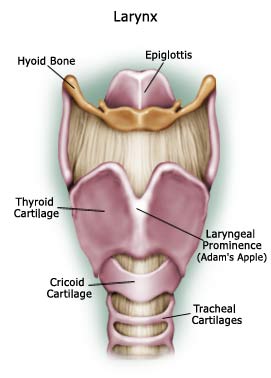Larynx
Short Note on Larynx
Definition
- Is a structure which produces voice; situated at the neck.
- Extends from the root of the tongue and the hyoid bone to the trachea.
- In front of the laryngopharynx at the level of C 3,4,5,6,
- Larger in the male Adam's apple.
Structure
Cartilages
Thyroid cartilage :
- most prominent, two flat pieces of hyaline cartilages or laminae fused anteriorly,
- upper border : thyroid notch
- superior cornu and inferior cornu - two processes projecting up and down
- upper part covered with stratified squamous and lower part with ciliated columnar epithelium.
- Gives attachment to many muscles at the outer surface.
The cricoid cartilage:
- below the thyroid cartilage
- encircles the larynx
- Articulates with the arytenoid cartilages above and with the inferior cornu of the thyroid cartilage below.
- Lined with ciliated colunar epithelium
- muscles and ligaments atached to its outer surface.
- Lower border of cricoid is the end of upper respiratory tract.
The arytenoid cartilages :
- pyramid shaped
- hyaline cartilage
- Forms part of posterior wall
- Give attachment to the vocal cords and to muscles and are lined with ciliatd columnar epithelium.
The epiglottis:
- Leaf -shaped
- fibroelastic cartilage
- attached to thyroid cartilage immediately below the thyroid notch.
Blood supply
Superior and inferior laryngeal arteries
Drained by the thyroid veins, which join the internal jugular vein.
Nerve supply
Superior and recurrent laryngeal nerves
parasympathetic from vagus
Sympathetic supply from superior cervical ganglia.
Interior of the larynx
Vocal cords - pale folds of mucous membrane with cord-like free edges
Extend from thyroid prominence to the arytenoid cartilages posteriorly.
Vibration of the cords produce voice.
Function of larynx
- Production of voice pitch, volume and resonance.
- Speech : voice produced by the larynx modified by tongue, cheeks and lips.
- Protection of the lower respiratory tract
- Passage way for air
- Humidifying, filtering and warming the air that enters the lungs.
Relations
Superiorly- the hyoid bone, root of tongue
Inferiorly - trachea
Anteriorly - muscles attached to the hyoid bone and the muscles ofhe neck
Posteriorly - the laryngopharynx and the 3rd to 6th cervical vertebrae.
Laterally - thyroid gland.





